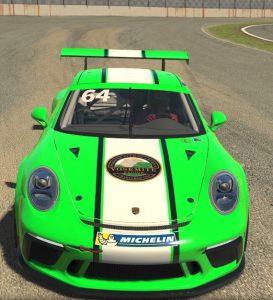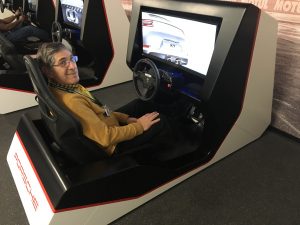PCA “Tech Tactics” programs are great forums to talk about topics of interest to members of PCA. An upcoming Tech Tactics, “How To Get Into SIM Racing”, should be no exception. But we in Yosemite Region have the opportunity to get a more intimate look at SIM Racing from a Yosemite Region member, Jeff Rosenthal, to not only understand “how to” get into SIM Racing, but get into the “why” and “how does if feel”. Jeff agreed to an interview to share his experience with starting and participating in SIM Racing, while not actually putting a high investment Porsche in harms way on the track.
_______________________________
YOS: Thank you, Jeff, for the opportunity to talk to you about SIM Racing. But first can you tell us a bit about your “Porsche/PCA” involvement?
Jeff: I’m fairly new to PCA and the region, joining after getting a Porsche Cayenne in Aug 2020. One day, I’ll add a “2-door” Porsche to my garage.
YOS: Were you always into virtual racing apps, of is this something new?
Jeff: I really didn’t have any particular experience with virtual — SIM racing before joining PCA, other than the usual toying around with “video game” type programs. But once I got into PCA and learned about PCA SIM racing, I was very interested. While I did a Skip Barber Formula Mitsubishi school many years ago, “tracking” much less “racing” a Porsche was not really in the cards for me quite yet. So I saw SIM Racing as something that I could do during the pandemic that was fun and accessible while still having that “competitive spirit”. So, I’ve only been doing SIM Racing for less than a year, but I’m ALL IN now!
YOS: So, what “is” SIM Racing?

Jeff’s “Cup Car”. Note the Yosemite logo on the hood!
Jeff: SIM Racing is the PCA’s supported and adapted racing league within the iRacing platform. iRacing has been around for quite a while, but PCA’s SIM racing is somewhat new. It has been growing very quickly over the last couple years. Now hundreds of PCA members that are actively racing in the program. And the technology has advanced dramatically even in the last year.
At its core, SIM Racing is not the “video game” of a couple years ago, it is an extremely realistic racing experience, competing with/against other PCA members from all across the county. Participants come from a variety of backgrounds, both young and “older” and include members who have considerable experience “physically racing”. Those folks really help bridge the virtual to the realistic SIM Racing experience.
And they are very open to share their experience(s). I’ve made many friends, both local and ex-California. One SIM Racing slogan is “Come to SIM for the racing, but stay for the people”. (Editor note: this is really close to PCA’s slogan, “its not just the cars, it the people”.)
YOS: So, not to be coy, but cutting to the chase — how real can SIM racing be?
Jeff: Your question brings up another PCA SIM slogan, “the cars aren’t real, but the racing is”. To your question, the iRacing technology is so advanced that SIM Racing “teaches” the physics of racing and car dynamics, even though the interaction is virtual. The system(s) provide the same racing “feelings” as in the physical world, but it is more affordable and safer than in the physical world (a crash in SIM is fixed with a simple reset button, a crash in the physical world of Turn 7 at Laguna is lot more expensive!) SIM racing teaches the basics of racing lines, braking points/zones, conserving momentum, and particulars of track irregularities and more. I can “feel” the car getting light cresting the front straight at Laguna Seca, the back end sliding going through T#3 and #4, car balance/reaction to FIA berms.
And I can tell you, at the beginning of a “race”, I get butterflies in the stomach as we roll to the start line, and after an hour of racing, I am physically and mentally tired.
YOS: I’ve read that professional racers, from IMSA to F1 use “simulators” to try out suspension settings, gain track familiarity and try out strategic moves. Is this what you are talking about?
Jeff: Sure, SIM racing also teaches overtaking and race strategy, skills that translate into the physical world. And you don’t use up your car doing it!
YOS: Can you describe starting a “race”?
Jeff: There are 4 classes, organized by skill level: Challenge, Sport, Club and Pro Classes. Fields of the typical race can have from 30 to 40 cars (participants), starts can be “standing” or “rolling”. In the case of a rolling start, there is a formation lap — but zig-zagging to warm tires is not allowed and the system imputes limitations on your car’s dynamics to reflect “cold tires” on the opening laps, so you have to take that into consideration. The first few laps are survival mode!! You have to be careful not to crash out another car — the system would assess damage to “his” and “your” car; and race stewards monitor such “incidents” and can/do apply penalties to guilty participants. All of this induces nervous energy — just as any opening laps in IMSA!
PCA SIM racing organizes weekly races in “seasons”. Participation has gotten so large that the “leagues” are broken down into geographical regions for Zone Group Challenges; I’m in the Wild West Zone. There are also “TeamRacing” series where 3 to 4 participants enter as a “team”. Those races have mandatory “pit” and “driver change” stops — with specified time outs to accommodate. The team members are not in the same place, so a driver change is the new driver taking over the team car using their home equipment. When you’re with 3 other PCA racers in a long event, you really builds camaraderie between participants — and I’ve made some really great friends in such events that I haven’t even met in “real life” yet.
But there are also “practice” events, sort of DE for SIM races. Experienced drivers offer coaching on the particular track that the race will be run on. The coaching details go into braking zones, watch out for the apex berm on turn 5, that sort of thing.
YOS: I’m getting the sense of being overwhelmed with the technology that powers this level of detail. The PCA Tech Tactics event is advertised to get into that sort of detail, but, based on your experience, what is needed to “get started” in SIM Racing?
Jeff: Since the program uses iRacing platform, you have to subscribe to iRacing. The monthly fee is about $10 per month. The PCA part is free to PCA members and we’re sponsored by Hagerty Motorsports (Title sponsor) , Z1Dashboard Analyzer for Challenge Class, Pirelli for Sport Class, Michelin for Club Class and Porsche for Pro Class. You have to “purchase” your car — its sort of an app fee of about $13 per car and is a one time purchase. Same thing for a license to a “track”, such as Laguna Seca, or Imola Autodromo, which is one of my favorites!
Then you need a PC computer (iRacing does not work well on Apple products), and a steering wheel/pedal combination it works best with “force-feedback” wheels to help with the realism. I use a Virtual Reality VR headset for even more immersion, but it’s not required. I’ve also added a subwoofer behind my “racing seat” that provides non-audible sensory input — helps to feel rumble strips, that sort of thing. Entry level equipment is available on Amazon, such as Logitech wheel/pedal combinations for less than $300. Professional level force feedback steering wheels and bases can run upwards of $1000, so the sky is the limit — But there are participants that use the most basic of hardware/technology and do very well and WIN races.
Maybe the best thing to do is have you drop by, take test spin in my system, maybe I can get a couple friends to call in and give you a chance to have other cars on the track. You have to feel it to really appreciate it.
______________________
 And, with that suggestion, this interview has morphed into a two part interaction with the next part being a report of (me) giving Jeff’s system a try. A bit of a confession first. I tried a SIM racing set up at the Porsche Experience Center in LA (before my on track coaching). I picked Lagua Seca to “try” since I have been doing DE’s with my Cayman(s) there since 2008. Easy peasy! After about 10 minutes, a very unproductive 10 minutes, I got motion sick and bolted to the restroom. All that is to set the stage for a very, very interesting challenge for Jeff!
And, with that suggestion, this interview has morphed into a two part interaction with the next part being a report of (me) giving Jeff’s system a try. A bit of a confession first. I tried a SIM racing set up at the Porsche Experience Center in LA (before my on track coaching). I picked Lagua Seca to “try” since I have been doing DE’s with my Cayman(s) there since 2008. Easy peasy! After about 10 minutes, a very unproductive 10 minutes, I got motion sick and bolted to the restroom. All that is to set the stage for a very, very interesting challenge for Jeff!
So, stay tuned for Part 2 of my “Interview with Jeff Rosenthal, YOS SIM Racing Chair”.
